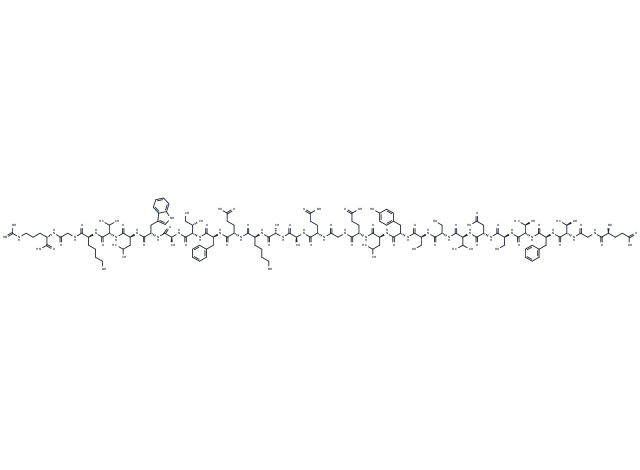Shopping Cart
Remove All Your shopping cart is currently empty
Your shopping cart is currently empty
GLP-1 (9-36) amide is an antagonist at the human GLP-1 receptor. GLP-1 (9-36) amide potently inhibits hepatic glucose production (HGP) and is a weak insulinotropic agent.

| Pack Size | Price | USA Warehouse | Global Warehouse | Quantity |
|---|---|---|---|---|
| 1 mg | $81 | In Stock | In Stock | |
| 5 mg | $255 | In Stock | In Stock | |
| 10 mg | $378 | In Stock | In Stock | |
| 25 mg | $626 | In Stock | In Stock | |
| 50 mg | $883 | - | In Stock | |
| 100 mg | $1,190 | - | In Stock |
| Description | GLP-1 (9-36) amide is an antagonist at the human GLP-1 receptor. GLP-1 (9-36) amide potently inhibits hepatic glucose production (HGP) and is a weak insulinotropic agent. |
| In vivo | After subcutaneous (s.c.) administration of GLP-1 to dogs the plasma immunoreactivity of GLP-1 measured by two different radioimmunoassays (RIAs) were higher than that measured by a sandwich enzyme-linked immunosorbent assay (ELISA). This discrepancy was due to the formation of the metabolites GLP-1-(9-36) amide, GLP-1-(7-35) and GLP-1-(7-34). Receptor binding studies using baby hamster kidney cells expressing the human pancreatic GLP-1 receptor showed that the affinity of GLP-1-(9-36) amide was 0.95% of the affinity of GLP-1-(7-36) amide. Furthermore, GLP-1-(9-36) amide was shown to be an antagonist to adenylyl cyclase activity. GLP-1-(9-36) amide was shown to be present in vivo in amounts up to 10-fold that of GLP-1-(7-36) amide[2]. |
| Molecular Weight | 3089.41 |
| Formula | C140H214N36O43 |
| Cas No. | 161748-29-4 |
| Smiles | CC[C@H](C)[C@@H](C(N[C@@H](C)C(N[C@@H](Cc1c[nH]c2c1cccc2)C(N[C@@H](CC(C)C)C(N[C@@H](C(C)C)C(N[C@@H](CCCCN)C(NCC(N[C@@H](CCCNC(N)=N)C(N)=O)=O)=O)=O)=O)=O)=O)=O)NC([C@H](Cc1ccccc1)NC([C@H](CCC(O)=O)NC([C@H](CCCCN)NC([C@H](C)NC([C@H](C)NC([C@H](CCC(N)=O)NC(CNC([C@H](CCC(O)=O)NC([C@H](CC(C)C)NC([C@H](Cc(cc1)ccc1O)NC([C@H](CO)NC([C@H](CO)NC([C@H](C(C)C)NC([C@H](CC(O)=O)NC([C@H](CO)NC([C@H]([C@@H](C)O)NC([C@H](Cc1ccccc1)NC([C@H]([C@@H](C)O)NC(CNC([C@H](CCC(O)=O)N)=O)=O)=O)=O)=O)=O)=O)=O)=O)=O)=O)=O)=O)=O)=O)=O)=O)=O)=O)=O |
| Relative Density. | 1.46 g/cm3 (Predicted) |
| Sequence | Glu-Gly-Thr-Phe-Thr-Ser-Asp-Val-Ser-Ser-Tyr-Leu-Glu-Gly-Gln-Ala-Ala-Lys-Glu-Phe-Ile-Ala-Trp-Leu-Val-Lys-Gly-Arg |
| Sequence Short | EGTFTSDVSSYLEGQAAKEFIAWLVKGR |
| Storage | store at low temperature,keep away from moisture | Powder: -20°C for 3 years | In solvent: -80°C for 1 year | Shipping with blue ice/Shipping at ambient temperature. |
| Solubility Information | 0.025% acetic acid: 2 mg/mL (0.65 mM), Sonication is recommended. |
| Size | Quantity | Unit Price | Amount | Operation |
|---|

Copyright © 2015-2025 TargetMol Chemicals Inc. All Rights Reserved.